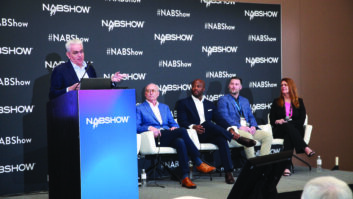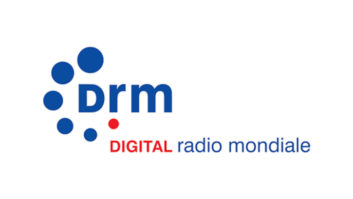Video is changing radio. Many radio stations and networks are adding a video component to their programming these days. Streaming video, video podcast and subscription video services allow radio broadcasters to reach a larger audience like never before. The days of slapping a webcam in the corner of the studio are gone.
Some of today’s radio studios look and function more like a TV studio than a radio studio, and Kim Komando’s new $7.5 million broadcast facility in Phoenix takes it to the next level.

Komando, “America’s Digital Goddess,” had called the WestStar TalkRadio Network’s 6,000-square-foot studios in Phoenix home since 1994. WestStar syndicates nine specialty radio programs carried on more than 1,500 radio stations that touch more than 24 million listeners a week.
In 2014, Komando and her husband and longtime business partner E. Barry Young, WestStar’s president/CEO, started making plans to build a new 24,000-square-foot broadcast facility including corporate offices, digital sales, entertainment, film operations, with a 24-hour network broadcast operations center, including all online operations. They wanted the centerpiece to be a 3,500-square-foot, 10-camera, HD-video studio to enhance their video component.
TEAM BUILDING
To build a radio studio in a TV studio for Komando, WestStar brought together an outstanding group of designers, engineers and integrators.
Innovative Show Design provided scenic design and integration, lighting design with more than 270 light fixtures and graphic packages for the project. Their portfolio includes sets and lighting designed for Super Bowl 49, College Football Awards, NBA TV, NFL Draft and World Series of Poker and many more.
Technical Innovation Broadcast Solutions Group spearheaded the TV master control (production control room), machine room (technical core), audio master, studio pictures, lobby pictures and front entrance sign design and integration. Some of their projects include Encompass Digital Media, Digital Convergence Alliance, KTVA TV facility buildout, KXAS TV facility buildout, Primerica-Corporate Broadcast Studio.
Jim Hibbard of Pacific Mobile Recorders Studio Builders provided design and integration of audio acquisition, storage and distribution throughout the facility. He was also responsible acoustical design of all the studios.
ROADWAY NOISE
This in itself is a major project. Acoustic material developments and technology have come a long way from egg crates and carpeted walls. Hibbard worked with architects and mechanical engineers to specify wall designs and HVAC specifications.

Most architects and mechanical engineers have no practical knowledge of acoustics, and most have never worked on broadcast facilities. Most of what they know is theory gained in school. Hibbard bridged this gap between theory and practical applications with his 30 years of experience of designing and building some 400 broadcast and recording studios.
One of the design factors was isolation of the noise from a nearby major thoroughfare. This was accomplished by using some of the new techniques for studio construction, such as a low-frequency viscoelastic polymer material manufactured by Acoustiblock. This 3 mm layer of material over a standard stud wall equates to the sound reduction of 12-inch poured concrete. Used on both sides would produce the same isolation at 24 inches of solid concrete. As sound waves hit this material, they cause it to flex and it transforms the sound to a small amount of heat. The viscoelastic principle is isothermal adiabatic.
In addition to Acoustiblock, Hibbard specified two layers of QuitRock sheetrock. Each layer of this sheetrock reduces sound transfer by up to eight times that of regular drywall. There was a combination of double wall and staggered stud construction with Rockwool insulation. Some of the walls were covered with Echostop perforated plasterboard to control the acoustics.

Hibbard had to pay particular attention to the HVAC design by adding additional supply vents and damping down the system to slow down the airflow. In addition to the HVAC noise, the room had mostly hard surfaces like a concrete floor and a Plexiglas desk reflecting sound throughout the studio. Beside the acoustic material on the walls, Hibbard came back after the lighting was done and added batting in the ceiling. Most of the batting used on the walls and in the ceiling was a recycled cotton material manufactured by several companies. This material can be left exposed due to its non-irritating properties, unlike fiberglass panels that must be covered.
On the studio walls outside the TV studio itself, walls were constructed with a framework that the cotton panels were wedged into, and then covered with tight fabric. Particular attention was made to the selection of acoustical tiles of the drop ceilings in the studios, to make sure they performed well in a studio environment. There was care taken to wrap the conduits in the studio to eliminate sound transmission. Hibbard’s major objective was making these studios as quiet and dead as possible.
COMPLEX FEEDS
Because of the complexity of feeds, and back feeds needed for this project and the complex control and signaling required, Hibbard chose Wheatstone for the audio and distribution in the facility.

There are two LX24 consoles, one in each of master control and the control room studio on the first floor; one L12 in TV master control; and one L8 in each of production 1 and 2. Wheatstone’s M4-IP3 blades handle all of the microphone processing in the plant. All PC and automation audio utilizes WDM audio drivers with 128 virtual logic ports. Wheatstone’s OLED Programmable Ethernet Button Panels handle all of the intercom and talkback needs, and interface to the Clear-com TV intercom system. There are two Aura8-IP blades in the TOC to control and smooth feeds in and out of the facility.
During the show, TV master control takes a stereo bus from the Wheatstone LX24 in the radio control room. During commercial breaks, Komando will get up from the table and move around the set. The radio breaks are longer than TV breaks, so Komando and her guest use lavalier microphones to feed audio to TV during this time. Hibbard installed a Wheatstone L12 console in the TV master control where the TV audio technician mixes these lavalier microphones for these breaks. Because of the power of IP audio, the mix of these lavalier microphones can be potted up in radio master control, if Komando or her guests do not end up back at the desk in time.
Vince Fiola of Studio Technology Studio Furniture designed, delivered and installed the studio furniture for the project. Fiola worked with Hibbard to assure sightlines were maintained and that ergonomic needs were met on the Corian-topped furniture.
This was accomplished by designing the furniture to allow for some adjustment to compensate for construction variations, and by cutting all of the console cutouts, monitor arm, microphone are placements on site. Hibbard selected Yellowtec Mika arms and Heil Sound booms and accessories throughout the space. Attention to detail and ergonomics were priorities for the studio layouts.
CUSTOM CABLES
Hibbard approaches project planning differently than most integrators.

He doesn’t have 100 percent of the design or layout of each and every wire in the plant before the install. He utilizes a general input list for sizing the system and specifying the equipment that is needed. He doesn’t configure anything until he has the opportunity to observe the operators and then he configures the system around their needs. He has a general layout that he tweaks during the installation. He maintains a balance between keeping the client comfortable with how they are accustomed to doing things, while utilizing the power of new technologies.
All of the net cues for the radio broadcast are handled through Wheatstone logic. The NexGen automation system provides these “closures” and turns off and on channels on the boards via the WDM drivers to Wheatstone. Button panels can augment or add closures as needed, directly into the IP system from anywhere. Net cues are connected to GPIOs in the Wheatstone system from satellite receivers to flash buttons for instant feedback of these cues to the operators. Wheatstone scripts can be written to monitor these return net cues and resend missing ones automatically in the event of a communication glitch.
With modern IP audio systems, there is no longer a need for rows and rows of punch blocks. Most of the wiring in these projects is point to point without the use of premade adaptors. Hibbard custom makes each cable for the project utilizing standard stranded shielded Cat-5e cable with a factory RJ-45 on one end and the connectors needed at the other.
ON-MIC
Hibbard uses a Neumann BCM 104 condenser microphone as Komando’s main microphone, and the guests are on Neumann KMS 104 condenser microphones. As anyone that has used a condenser microphone in a studio knows, it will pick up spider footsteps from 10 feet. Hibbard added additional batting in the ceiling and was a lot more aggressive on the microphone processing, because TV is not miked as tight as radio. Hibbard chose Wheatstone M4-IP3 blades for all microphones processing, because the downward expansion is identical to the M1, which he utilizes any chance he can. He’s also used these processors on the lavalier microphones for “The Rich Eisen Show” and “The Dan Patrick Show.”

The TV side uses a Clear-Com intercom system with wireless belt packs to communicate with camera operators and technicians. Hibbard took all of the inputs and outputs of the Clear-Com system and switches it through the Wheatstone system. It became a hybrid intercom system between Clear-Com and Wheatstone utilizing the powerful mixers, built into each blade, to handle mixing and switching. For the phone system, Hibbard took a Telos TWOx12 system and replaced the ISDN cards with POTS cards. The telephone service comes in the facility via a T1 that is converted to POTS and connected to the Telos TWOx12 system.
Distribution of the radio program is via good old ISDN. Banks of Telos Xstreams and Telos Classic ISDN codecs carry the primary audio to the Westwood One TOC. In addition, WestStar uses Comrex BRIC-Links as a redundant path to the TOC.
WestStar needed reliable Internet service in their new facility. They installed two 1 gigabit fiber lines from two separate providers utilizing Border Gateway Protocol. This assures reliable and redundant Internet service to support WestStar’s in-house hosting of all its websites, audio streaming and the reliable delivery of the video broadcast to Tata Communication for video streaming distribution.
Radio continues to evolve and change to maintain its place in multimedia entertainment. This new facility for WestStar TalkRadio Network and “The Kim Komando Show” is a perfect example of the marriage of radio and TV.





